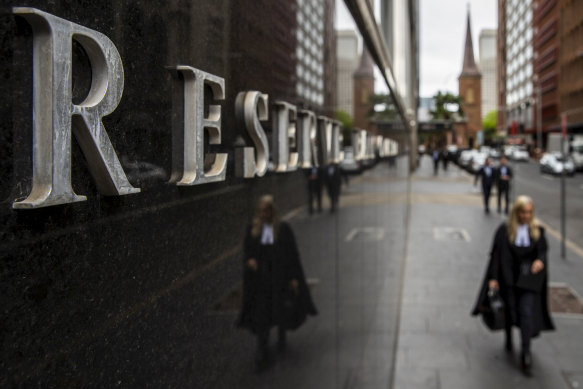Market meltdown is an ominous sign for interest rates
Loading
There is a strong argument for that larger move and for further (perhaps not quite as large) rises at the remaining committee meetings in November and December.
The Fed needs to get ahead of expectations and make a significant dent in consumer and investor confidence – and probably economic growth in the process – if it is to drive the inflation rate down. It is also probably going to have to keep raising rates faster and further than it might itself have envisaged.

The RBA has increased official interest rates for a record five-straight months.Credit:Louie Douvis
Where those in the markets saw rates peaking either late this year or early next year around 4 per cent, it now looks likely that peak will occur well into next year and solidly above 4 per cent, although this is, of course, a volatile environment.
The data, self-evidently, wasn’t good news for investors in either equities or bonds in what has been a horrible year thus far for investors.
Loading
The US sharemarket is down about 18 per cent this year and bond market investors are experiencing their first bear market in decades. Worst-hit have been investors in technology and other high-earnings multiple stocks, with the tech-laden Nasdaq index down 5.2 per cent in response to the inflation numbers and now down 27 per cent from its peak late last year.
The data, and the Fed’s likely response, is also ominous for markets and economies outside the US given that the Fed’s chairman, Jerome Powell, has made it clear that the Fed will be driven by the data and do what it takes to bring inflation under control.
Not only does the US Treasury market act as a benchmark for all other bond markets but rate differentials between the US and other economies drive currency movements.
As the Fed has moved faster and harder than the other major banks this year, the US dollar has strengthened almost 15 per cent against the basket of its major trading partners’ currencies. If they want to avoid destabilising capital outflows and depreciation of their own currencies (and higher inflation as a result) other central banks are under increasing pressure to emulate the Fed.
The strengthening of the dollar has particularly unpleasant impacts of economies that need to import commodities (most of which are priced in US dollars) and which have high levels of US dollar-denominated debt.

The Fed is struggling to rein in US inflation. Credit:AP
Those are generally the emerging market economies, although the energy crisis in Europe and Europe’s mad scramble to secure supply at any price to replace gas that used to flow from Russia means the eurozone, too, will now be under even greater pressure.
While the European Central Bank recently increased its policy rate by a record 75 basis points, at 1.25 per cent the ECB is well behind where the Fed is today let alone where it might be next week and is in the uncomfortable position of knowing it has to raise rates to kill of surging eurozone inflation rates and avoid being crushed by dollar strength even as the zone heads almost inexorably towards recession.
The Reserve Bank doesn’t confront the ECB’s challenges but it has always been very conscious of the implications of the Fed’s decisions for the value of the Australian dollar and the flow-on effects of currency weakness on inflation and growth.
Loading
The only brighter spots in the macro settings are the falls in oil prices – the price is now down below $US94 a barrel from a peak earlier in the year of almost $US130 a barrel and OPEC is cutting rather than increasing supply – and signs that the disruptions to global supply chains that have bedevilled the global economy and played a major role in igniting the breakout of global inflation are gradually disappearing.
Those positives, however, only serve to stress how challenging and stubborn the current high-inflation environment is and make it more likely than not that central banks will be forced into far more aggressive action than they, or those in the market, were anticipating even in the days leading up to the latest release.
The Business Briefing newsletter delivers major stories, exclusive coverage and expert opinion. Sign up to get it every weekday morning.
For all the latest Business News Click Here
For the latest news and updates, follow us on Google News.
